ZEN MESTEREK ZEN MASTERS
« Zen főoldal
« vissza a Terebess Online nyitólapjára
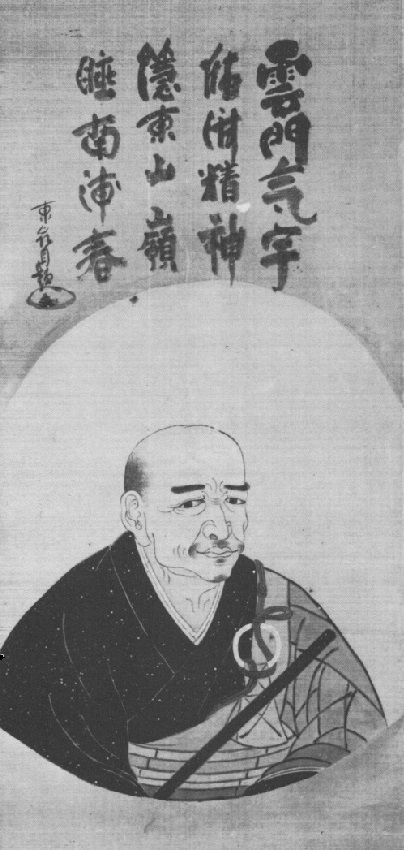
東嶺圓慈・東嶺円慈・東嶺延慈 Tōrei Enji (1721–1792)
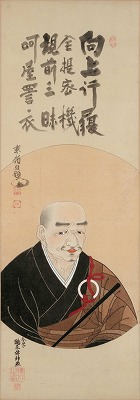
Tōrei Enji (1721-1792) was born into the Nakamura family, the proprietors of a pharmacy located in the station town of Obata (present Gokasho), on the eastern shores of Lake Biwa in present-day Shiga Prefecture. At the age of nine he went to the nearby temple Daitoku-ji, where he studied under the priest Ryōzan Erin. He received the name Etan, which was later changed to Dōka. From the age of seventeen he went to Daikō-ji, located in present-day Miyazaki Prefecture on the island of Kyushu, to train under the important Zen master Kogetsu Zensai (1667-1751) and his successor Suigan Jūshin (1683-1773). From the age of twenty-three he trained under Hakuin at Shōin-ji in Hara, receiving inka at the age of twenty-nine. At thirty-five he received priestly rank at Myōshin-ji and was first referred to as Tōrei. In addition to serving as abbot of Ryūtaku-ji in Mishima (in present-day Shizuoka Prefecture), he restored the temples Muryō-ji in Shizuoka and Shidō-an in Tokyo. He later resided at Zuizen-ji, near present-day Nagoya, and Reisen-ji near his birthplace. Throughout his life Tōrei retained an interest in Shinto and Confucianism as well as Buddhism, stressing the ultimate unity of these three teachings. His posthumous title was Butsugo Shinshō.
“Did Tōrei become what he was because of Hakuin, or did Hakuin become what he was because of Tōrei?” That such a question is often asked testifies to the importance of the role of Tōrei Enji (1721-1792) in ensuring the continuation of Hakuin Zen. Tōrei was instrumental in spreading the teachings and methods of his teacher not only in the Rinzai Zen world but also among lay Zen practicers. He and Suiō Genro (1717-1789), another great disciple of Hakuin, were together known as the “two divine legs [eminent students] of Hakuin.”
Zen insight was not the only legacy these disciples received from their master, however. Both followed Hakuin in becoming accomplished painters and calligraphers who left numerous examples of their artistic talents. Tōrei, in particular, produced strikingly original works that continue to impress people even today. Much of their appeal lies in the interesting contrast between the subtlety of Tōrei's Zen and the boldness of his artistic style, which, though influenced by that of Hakuin, surpasses it in force.
Tōrei Enji 東嶺圓慈・東嶺円慈・東嶺延慈 (1721–1792) received the posthumous imperial title of Butsugo–shinshō Zenji 佛護神照禪師・仏護神照禅師. After having followed
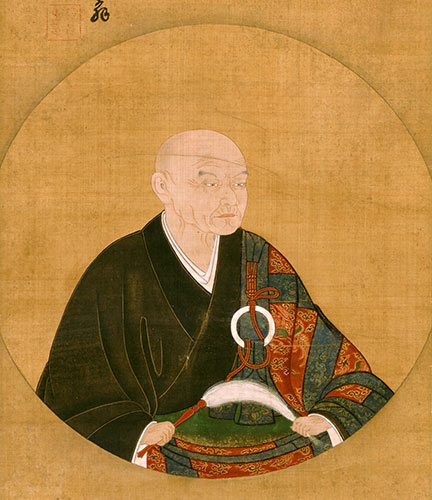
Kogetsu Zenzai 古月禪材・古月禅材 (1667–1751),
Tōrei became the disciple of Hakuin Ekaku 白隱慧鶴・白隠慧鶴 (1686-1769), one of the major figures in the Rinzai revival of the eighteenth century. Many of Tōrei's works remain unpublished, even in Japan. His scholarly interests and the breadth of his knowledge, including Shinto, was unprecedented.
For further information about Tōrei, see:
http://pl.wikipedia.org/wiki/T%C5%8Drei_Enji
http://www.kihindo.jp/kobokuseki/rinmyou/tourei.html
http://www.hanazono.ac.jp/event/20120918-2188.html
http://www.mingei-arts-gallery.com/stick/
Tōrei Enji—Shūmon mujintō ron
PDF: The Inexhaustible Lamp of Faith: Faith and Awakening in the Japanese Rinzai Tradition
by Erez Joskovich
Japanese Journal of Religious Studies 42/2: 319–338 © 2015 Nanzan Institute for Religion and Culture
In the modern period, Zen has often been depicted as a faithless form of spirituality that favors discarding authority and encourages existential doubt. The primary objective of this article is to challenge this assumption by highlighting the importance of faith in the Zen tradition. To achieve this goal, I focused on Shūmon mujintō ron, a major text of the Rinzai tradition, written by the eminent Japanese master Tōrei Enji (1721–1792). After establishing “faith” as an analytic category for studying Zen, I adopted the philosophical framework of necessary and sufficient conditions in order to elucidate the relationship between faith and awakening, as well as the interdependency of faith and doubt in Zen training. By examining the role of faith in the text, I shed new light on the role of faith in the Zen tradition, particularly in Rinzai training.
PDF: Relying on Words and Letters: Scripture Recitation in the Japanese Rinzai Tradition
by Erez Joskovich
Japanese Journal of Religious Studies, 46/1: 53-78 © 2019 Nanzan Institute for Religion and Culture
Classical Chan/Zen literature is famous for its ostensive disparagement of scriptural authority. In practice, however, sutra recitation and invocation of dhāraṇī have been a significant and influential component of Zen monastic life throughout history. Daily and monthly sutra-recitation services take up more of the monks' time and effort than any other activity. This article examines the liturgical function of Buddhist scriptures within the Japanese Rinzai tradition. It also aims to better understand how Zen practitioners interpret the meaning and purpose of sutra recitation and how they bridge the aforementioned gap between soteriology and practice. I explore the Kankinbō chapter of Goke sanshō yōromon, written by the eighteenth-century Japanese Rinzai monk Tōrei Enji. Tōrei focuses on the mental and physical benefits of sutra recitation and its power to positively affect natural and supernatural environments. This illustrates the multifaceted understanding of texts as ritual objects, one that challenges strict distinctions between worldly benefits and spiritual cultivation. Tōrei's exegetical efforts to explain the function and justify the legitimacy of sutra recitation attest that the tension between antinomian rhetoric and worship was a major concern for Zen reformers in Edo Japan. Accordingly, I contend that the Kankinbō can advance our understanding of the meaning and function of rituals within Edo-period Zen and shed new light on modern interpretations of the tradition.
PDF: The Biography of Shidō Munan Zenji
(Kaisan Shidō Munan Anju Zenji anroku)
Compiled by Fufu-anju Enji (Tōrei Enji, 1721-1792)
With an Introduction by Kobori Sōhaku
Trans. by Kobori Sōhaku & Norman A. Waddell
The Eastern Buddhist, New Series. 1970, NS03-1, pp. 122-138.
PDF: The Undying Lamp of Zen - The Testament of Zen Master Torei
Trans. & ed. by Thomas Cleary
Boston & London, 2011
PDF: The discourse on the Inexhaustible lamp of the Zen school
[Shūmon mujintō ron]
by Tōrei Enji; with commentary by Master Daibi* of Unkan; translated by Yoko Okuda**
Foreword by Myokyo-ni
Published in Association with The Zen Centre, London, 1989
Boston : C.E. Tuttle Co., 1996. 560 p.
*Shaku Taibi 釈大眉 (1882-?); Unkan 雲關
**Okuda Yōko 奥田陽子"Based on the teachings of the great Zen Master Hakuin Zenji, The Discourse on the Inexhaustible Lamp of the Zen School is an essential guide to Rinzai Zen training. It was written by Torei Enji Zenji (1720-1792), Hakuin's dharma successor. In this book, Master Torei begins by providing a concise history of the Rinzai school and lineage. He then details all the important aspects of Zen practice, most notably great faith, great doubt, and great determination. He also provides explanations of koan study and zazen (meditation) as a means of attaining true satori (enlightenment.). This edition includes extensive commentary by Master Daibi, providing both essential background information and clarification of several Buddhist concepts unfamiliar to the general reader. The result is an invaluable record of traditional Zen training."
Practical Principle Of Hakuin Zen Examined in the Text By His Disciple Tourei-Enji
by Eshin Nishimura
Professor of Department of Buddhism, Hanazono University
http://kr.buddhism.org/zen/koan/eshin_nishimura.htm
MICHEL MOHR
http://www.hawaii.edu/religion/cvs/mohr.pdf
“Vers la redécouverte de Tōrei” [Towards the Rediscovery of Tōrei],
Les Cahiers d'Extrême-Asie, no. 7, 1993–94, Special Issue on Chan and Zen Buddhism, pp. 319–52 (in French).
http://www.persee.fr/doc/asie_0766-1177_1993_num_7_1_1070Traité sur l'Inépuisable Lampe du Zen: Tōrei (1721–1792) et sa vision de l'éveil [Treatise on the Inexhaustible Lamp of Zen: Tōrei and his Vision of Awakening], 2 vols.
Mélanges chinois et bouddhiques vol. XXVIII. Brussels (Bruxelles) 1997: Institut Belge des Hautes Études Chinoises.
http://www.peeters-leuven.be/boekoverz.asp?nr=6719“Emerging from Non-Duality : Kōan Practice in the Rinzai Tradition since Hakuin.”
In The Kōan: Texts and Contexts in Zen Buddhism, edited by Steven Heine and Dale S. Wright. Oxford and New York, 2000, pp. 244–79.“Imagining Indian Zen: Tōrei's Commentary on the Ta-mo-to-lo ch'an ching and the Rediscovery of Early Meditation Techniques during the Tokugawa Era.”
In: Zen Classics: Formative Texts in the History of Zen Buddhism, edited by Steven Heine and Dale S. Wright. Oxford and New York, 2006, pp. 215–246.“Beyond Awareness: Tōrei Enji's Understanding of Realization in the Treatise on the Inexhaustible Lamp of Zen, Chapter 6.”
In: Buddhist Philosophy: Essential Readings, edited by William Edelglass, and Jay L. Garfield. New York: Oxford University Press, 2009, pp. 159–170.Filial Piety with a Zen Twist: Universalism and Particularism Surrounding the Sutra on the Difficulty of Reciprocating the Kindness of Parents
Journal of Religion in Japan, 2013. 2 (1): 35–62.This article examines the Sutra on the Difficulty of Reciprocating the Kindness of Parents (Fùmǔ ēn nánbào jīng 父母恩難報經, T 16 no. 684) and its reinterpretation by the Japanese Rinzai Zen monk Tōrei Enji 東嶺圓慈 (1721–1792). In the context of the Tokugawa period (1600–1867) where filial piety was upheld as one of the pillars of morality and Neo-confucian orthodoxy, Tōrei's commentary of this sutra skillfully combined the particularist understanding of filiality as limited to one's relatives with its broader construal as a universal attitude of reverence directed toward all sentient beings. The father is envisioned as the wisdom and the excellence of the Buddha, the mother as the compassionate vows of the Bodhisattva, and the children as those who emit the thought of awakening. Tōrei further pushed this interpretation by adding the distinct Zen idea that the initial insight into one's true nature needs to be surpassed and refined by perfecting the going beyond (kōjō 向上) phase of training, where the child/disciple's legacy and his indebtedness towards his spiritual mentors is recast in terms of overcoming one's attainments and attachment to them.
Immeasurable Devices: Their Treatment in the Damoduoluo chanjing and Further Distillation in Japanese Zen
Dharma Drum Journal of Buddhist Studies 16: June 2015, 63–94.
![]()
Works by Tōrei Enji
http://evols.library.manoa.hawaii.edu/handle/10524/33745
The Spur by Tōrei Enji
Translated by Trevor Leggett
Kaibaben 快馬鞭 A Swift Horse's Whip
The Essential Secrets for Entering the Way - Words of Master Torei
Translated by Thomas F. Cleary
In:
The Original Face: An Anthology of Rinzai Zen, Grove Press, 1978. pp. 141-158.
In what the Zen school calls ascending directly from the
state of ordinary man to buddha, there are five discrimi-
nations: one is the meaning of same nature, second the
meaning of different paths, third the meaning of
urgency, fourth the meaning of progressive practice,
and fifth the meaning of returning to the basis. This is
the essential road.First, same nature: the fundamental nature inherent
in sentient beings is not other than the fundamental
nature of all the buddhas of the past, present, and
future. Their range of powers and qualities are also
equal, their lights are radiant; their knowledge, wisdom
and miraculous powers are all the same. This may be
likened to the light rays of the great solar disc shining
everywhere on the mountains, rivers, and plains, so
nothing is not illumined. Gold and jewels are bright in
themselves even when they are in mud. However, blind
people do not see, are not aware of this light, even
though they are in its very midst; they are to be pitied.Second, different paths: although in their fundamen-
tal nature buddhas and sentient beings are the same
substance, no different, the directions of their minds are
different. Buddhas shine inward to illumine the basic
mind, whereas sentient beings turn outward and get
involved with myriad things. That is why sentient
beings create greed and lust for things they desire,
anger and rage towards people they dislike, and become
fools by becoming congealed in their thoughts; con-
fused and stupefied by these three poisons, they have
lost their very fundamental mind.Those in whom greed and lust run deep turn into
hungry ghosts, those in whom anger and rage run deep
become antigods, and those deep in folly and delusion
become animals; those in whom the three poisons are
equal fall into hell and suffer various miseries. These
are called the four bad dispositions; they are most
dreadful.Even though they have greed, anger, and folly, those
If you want to be free from this world of suffering,
who restrain themselves and are not self-indulgent are
human, and in this way will not lose this bodily form
life after life. Those in whom greed, anger, and folly
gradually quiet down, and who are not self-indulgent
even though they don't restrain themselves are born in
heaven, known as gods of the six heavens of desire.
Those in whom the nature of the three poisons has died
out, but though they have qualities of calmnes s and
wisdom, they have views attached to calmness and have
residual habits of aversion and ignorance, are born
among the eighteen kinds of heaven of pure form.
When the love for calmness is done with but one has
not yet opened up the knowledge and insight of the
enlightened ones, this is called the four formless
heavens; those who practice discipleship and self-
enlightenment are in these latter heavens. If you are
wondering how this all comes about, you create these
worlds with your minds deeply afflicted by greed,
anger, and folly, producing such bodily forms as a
result. Therefore, unless you extinguish these afflictions
and their active expressions, you cannot be liberated;
unless you are liberated from the world of suffering of
these six dispositions, there is no real peace.
first you must contemplate impermanence. Those who
are born must inevitably die. Even the young are not
exempt; even the strong are in danger. Even the rich and
prosperous decline, even the noble and exalted cannot
remain that way. Even a long life does not last more
than eighty years or so. Thus, this world being imper-
manent, there is nothing enjoyable. The poor suffer
from lack, the rich suffer from possessions, the high
suffer from their high status, the low suffer from their
low status; they suffer over food and clothing, suffer
over wives and children, suffer over wealth, suffer over
official rank. Anyway, if you don't annihilate the nature
of afflictions somehow and arrive on the path of
liberation, even if you ascend to the rank of sovereign
of a nation, great minister, deity, spirit, or wizard, it is
still evanescent as lightning and morning dew, lasting
only for a while.When conditions meet, everything sure seems to
exist; but when the conditions disintegrate, emptiness.
This body is gotten through the relationship of father
and mother, comes from their conditions-solidity be-
comes skin, flesh, ligament, and bone; fluidity becomes
spittle, tears, pus, and blood; heat becomes warmth and
flexibility; air becomes breath and movement. When
these four conditions suddenly are exhausted, the body
gets cold and the breath stops-there is nothing called
"me." At that time this body is really not our own; it is
only a temporary inn. How can we be so greedily
attached to this temporary inn that we ignore eternity?Contemplating these four transcendences-imper-
manence, suffering, emptiness, selflessness-seeking the
way of enlightenment, is called "the teaching of four
realities, for disciples." This is the essential gateway to
beginning entry into the way for all enlightened ones.Also the twelve causal conditions, for those who can
become enlightened by understanding conditionality,
are as follows. When the original mind is in the dark, it
produces various activities; these are the two [condi-
tions]: ignorance and action. As actions accumulate,
they become instinctive; the parents copulate and the
embryo dwells within; these are consciousness and
name and form. When the body is complete and its six
faculties finally developed, this is called "the six media
[of sense]." Being born, yet not yet distinguishing good
and bad, is called "contact." After the age of two or
three, people already enjoy good tastes and beautiful
colors; this is called "sensation." After the age of ten,
there is longing for goods and sex; this is called
"craving." Past fifteen or sixteen, people greedily cling
to one thing after another; this is called "grasping."
From the age of twenty, when you do your adult work
without fear of wrongdoing, is called "becoming."
When you are doing what you do and piling up faults,
the condition of your future life, for good or bad, is
decided therein; this is called "birth." Doing such things
all your life, you get old and feeble and die. These are
called the twelve causal conditions of human life. Those
who are enlightened by understanding these conditions
examine them, put an end to passion and affliction, and
enter enlightenment. These are all techniques of the
enlightened ones for entering the way. When you
understand the mind darkened by ignorance and see its
real nature, then ignorance becomes identical to the
enlightened nature, action is the way, consciousness
becomes the power of knowledge. Then the twelve
causal conditions all accord with the right way and
eventually arrive at the great realization of liberation.Also the six transcendences of bodhisattvas are
generosity, morality, tolerance, effort, meditation, and
wisdom. The preceding two gateways of practice, of
disciples and those enlightened by understanding con-
ditions, benefit oneself only individually and do not
have the principle of helping others. Bodhisattvas
include the teaching of others in practicing the way for
their own benefit as well. They do not spare their
wealth when it is for the true way; they make offerings
to teachers and give donations to the poor. This is called
"material generosity." According to their own depth of
knowledge and virtue, they teach and influence others;
this is called" generosity with the teaching." Practicing
these two kinds of giving to all sentient beings is called
"the transcendance of generosity."Inwardly guarding your spirit of the way, observing
fundamental ethics and their ramifications, is called
"the transcendence of morality."Accepting the truth you see, not affected by circum-
stances of blame or praise, not giving birth to a single
thought of anger or resentment, is called "the transcen-
dence of tolerance."Growing day by day in the great work of helping
yourself and helping others, warding off laziness and
diligently progressing, is called "the transcendence of
effort."Concentrating wholeheartedly on directed effort in
sitting meditation and becoming free from all illusions
is called "the transcendence of meditation."Exhaustively studying the principles of the teachings
and examining the intent of the Buddha, consciously
breaking up all delusive feelings, is called "the tran-
scendence of wisdom." These are called "the six
transcendences of bodhisattvas."These practices of disciples, those enlightened
through disruption of the causal chain, and bodhisatt-
vas-those who struggle for everyone's enlightenment-
are called "the three treasuries"; they are also called
"the three vehicles." They are techniques of the bud-
dhas for realizing the path, principles that do not
change for a thousand ages. When students of the one
vehicle of buddhahood say these are teachings of the
three treasuries of the lesser vehicle and reject them, it
is to break up the biased view of the lesser vehicle and
awaken them to the wonderful truth of the great
vehicle. If you believe in the wonderful truth of the
great vehicle, then the gateways of practice of the three
vehicles are all helpful wings of the great vehicle. It is
like the case of the people and slaves, who are of lower
class than the lords and rulers; when the people and
slaves are rejected, the lords and rulers lose their
authority. Because the people are many, the ruler is
noble. Because of the fulfillment of the lesser vehicles,
the great vehicle is broad and far reaching. Even the
buddhas of the past, present, and the successive genera-
tions of enlightened ancestors reached actualization of
truth by way of the practical entrances of the three
vehicles.Now people with minds should think clearly; among
the pains and troubles of the four bad dispositions,
which would you not fear? The blessings and powers of
humanity and godhood cannot be relied on either.
Anyway, the four realities of disciples are good practice
for each of them; everything in this world is misery.
Impermanent, it is a desolate house. Whatever may be
eventually returns to emptiness. Even one's body is not
one's own possession-how much less wives, children,
valuables, or kingship, followers, oxen, horses, and so
forth! When you die, you go alone; who goes with you?
What can you take along with you?Strangers in the present were parents and children,
husbands and wives in former lives; parents and
children and husbands and wives of the present are
strangers of the future. Oxen, horses, fish, and birds of
the present are relatives of former lives; relatives now
are oxen, horses, fish, and birds of the future. Drawn by
force of actions, following circumstances, it's hard to
judge what form of life, what kind of body one may
have to experience. Therefore, once you are separated
from your parents and children, husbands or wives,
those closest to you in the present, you don't know
where they are or what they turned out to be. The
closeness of bone and flesh even is only for fifty years.
It is like deeply loving an overnight guest, disliking
other people. When the night is over and the friend
leaves, that friend goes east or west, wandering on
alone. The people you didn't like before become friends
for a night.The only thing worthy of prayer and trust is
enlightenment; the only thing to be sought is the
actualization of buddhahood. This body is a skin bag of
habitual obstructions produced by the twelvefold rou-
tine of conditioning. First you must break up the root of
ignorance; once the root is broken, the branches and
leaves cannot remain. Practice generosity with goods
and teaching, according to your means. Keep the
Buddha's precepts without violating them. Tolerate
people and don't become angry. Pray and pledge to the
buddhas and spirits morning and night; progress dili-
gently without forgetting thought after thought. If you
have free time, sit in meditation. When you hear the
true teaching, consciously break through illusion. These
are the practices of the six transcendences of
bodhisattvas.Although their fundamental natures are the same,
buddhas turn inward while sentient beings run out-
ward-from this moment of error, they have divided
into sentient beings of nine realms; hell beings, hungry
ghosts, antigods, humans, and deities, the six disposi-
tions, and disciples, those enlightened by conditions,
and bodhisattvas, the three vehicles. This is the mean-
ing of different paths. If you return to the source, these
are of the same substance as the buddhas; is this not to
be hoped for?Third, the sense of urgency means that if you want
to realize the same nature of all buddhas, first you must
clearly understand the root of ignorance. This is done
by questioning your own fundamental nature. How to
do this? Seeing colors with the eyes, hearing sounds
with the ears, feeling cool and hot with the body,
discerning pleasant and unpleasant in the mind. This is
called seeing, hearing, awareness, knowing; these are
the seeds of practice. Ordinary people get confused by
form when they see it, get confused by sound when
they hear, get confused by cold and hot when they feel,
get confused by pleasant and unpleasant when they
cognize; this is what I call "sentient beings turning
outward."As for the practice of bodhisattvas, when they see
forms, they question what it is that sees; when they
hear, they question what hears; when they feel, they
question what feels; when they cognize, they question
what cognizes. This is what I call the "buddhas turning
inward." When you practice like this, your orientation
is different from that of ordinary people, as mentioned
before-it is the same as the orientation of the buddhas,
and even if you don't fully realize their wisdom and
powers, you should realize that a fledgling bodhisattva
has entered the intermediate state.Always make great vows to the buddhas, pray to the
spirit luminaries and make pledges to the ancestral
teachers; in this way fulfill the great matter once and
sport in the ocean of vows to help self and others.
When you get up in the morning, no matter how
hurried you are, first arouse this one thought; try this
meditation work in seeing and hearing, and after that go
about your business. When you eat, make this thought
first and try this meditation. When you go to the toilet,
make this thought first and try this meditation. When
the day is over and you are going to bed, first sit awhile
in bed with this thought foremost; try this meditation
before lying down to sleep. This is the practice of the
true and straight road of the buddhas and bodhisattvas.
Disturbed by the fact that you have lost the original
nature which is of the same substance as all the
buddhas and come to wander through the six disposi-
tions and four kinds of birth, turn to your fundamental
nature and urge on your meditational efforts. This is
called "the sense of urgency.Fourth, the meaning of progressive practice means
that as you urge on your meditation on the fundamental
as just described, you should progress moment after
moment, practicing in everything. Summoning forth the
state of correct mindfulness in meditation, when you
walk you practice while walking, when you rest you
practice while resting; when speaking with people you
practice while speaking, and when silent and quiet urge
on your correct mindfulness all the more. When seeing
things, doubt the seer; when hearing things doubt the
hearer; when things are busy and it' seasy to get
distracted, doubt that which is distracted; when you
question what it is that gets distracted, then even when
distracted you do not lose the right mindfulness of your
meditation effort. When sick, you should use your
misery as a seed of meditation effort. Anyway, even
when things are busy, this, too, should be a way of
progressing in meditation; if things are quiet all the
time, there won't be energy in your meditation. With-
out energy in meditation, there is no empowerment.When quelling disturbance in the country, when
everything is at stake and in the midst of the danger of
battle you fight back and forth without fear, that is
when you win victory. The Dharma battle of meditation
work is also like this; when distracted by various things
and disturbed by various thoughts, that is a good time
to decide victory or defeat. In this frame of mind,
without laziness, you should progress. When things are
quiet, this is really a matter of practicing military arts
inside the castle; so understanding, you should cultivate
practice with utmost sincerity. When things are busy,
this is the time to decide victory or defeat on the field of
battle; so understanding, you should concentrate your
effort on directing meditation. Even if you don't attain
power, in doing this, in both cases you will be people
prepared for the straight and true road of the buddhas
and bodhisattvas.For example, someone in the prime of life is able to
walk miles a day, whereas someone who is weak can
walk only a short way. In going to a distant country, the
strong one may easily get there in a few days, while the
weak one may take a few weeks... nevertheless, once
they are arrived they are in the same country, among
the same people. Whether one has sharp or dull
faculties or disposition is like this, too; it is the same as
being sickly and having a hard time getting there or
being strong and going with ease-depending on
whether people are sharp or dull, whether their faculties
are strong or weak, there will be differences in how
quickly or slowly they become enlightened and find the
way. [But] when it comes to the attaining of the way
through practice, there is no difference. Should we not
take this opportunity? I hope that whether you are
smart or stupid, noble or mean, you will make prepara-
tions for journey on the way by this direct practice.There is another meaning within this progressive
practice; when effort is pure and ripe, without thinking
of it or considering it, you will find empowerment. Even
though you get power, you shouldn't be lazy about
cultivating practice. If you concentrate energy, em-
powerment comes of itself, so there are great and small
empowerments; lesser enlightenment, after all, turns
out to be a hindrance to great enlightenment. If you give
up lesser enlightenments and don't cling to them, great
enlightenment will surely be realized. If you grasp little
enlightenment and don't relinquish it, great enlighten-
ment will surely be ignored. This is like someone so
greedy for a little profit that he doesn't get a big profit; if
he doesn't cling greedily to a little profit, great profit
will eventually be realized; if he accumulates small
profits, eventually it will amount to great profit.If you cling to a lesser benefit and do not progress,
spending your whole life within the limits of only a
small realization, you can't reach the realm of great
freedom and great liberation. Unless you arrive at great
enlightenment and find the path of great freedom, fact
and principle do not harmonize, so you enter into
outside paths with false views. This is dreadful. Once
you have some small enlightenment, if you use this as a
seed to progress further and further, the great reward of
all the buddhas will be revealed. You pass naturally
through the barrier locks of the ancestral teachers, fact
and principle truly accord, with action and understand-
ing not different, you reach the sphere of great libera-
tion and great independence. This is called "the essen-
tial secret of progressive practice."Exhausting the inner principles of all things, perfect-
ing all virtues of the way as a benefactor of all sentient
beings everywhere, explaining the truth, teaching and
influencing according to potential and situation yet
without anything lacking, one arrives together with
others at the shore of four qualities (self, purity, bliss,
eternity) of great nirvana. With this great practice and
great vow, make self-help and helping others your task
in every life in every world, never turning back for all
time.In the meantime, though you may make mistakes
and regress, if your legs are weak and the road slippery,
you fall and you'll die there if you don't get up; yet if
you keep getting up when you fall and keep going on,
eventually you'll get there. When it says in the scrip-
tures that when we commit a fault we should repent
right away before the buddhas, and again proceed on
the path, this is what it means.Fifth, the. meaning of returning to the basis; as the
work previously described progresses and your practice
becomes wholly mature, eventually you return to the
nature of the same one substance of all the buddhas.
This is called fulfilling buddhahood. This is what is
referred to in the Zen schools as seeing real nature and
fulfilling buddhahood. When the first thought goes
wrong and instead of turning inward to the basic mind
it ranges outward to myriad objects, floating and
sinking in the six paths of hells, hungry ghosts, animals,
antigods, humans, and gods, lives apart, generation after
generation, revolving in these routines for a thousand
lives over myriad eons, like the wheel of a cart. We
have experienced the same pains and troubles countless
times; if the bones of every life were piled up, they
would be higher than a mountain, and if their pus and
blood were stored, they would be more than the waters
of the ocean; so the realized one has explained.Now, having a human body, so difficult to get, and
having encountered the teaching of enlightenment,
which is especially hard to encounter, and therein to
have heard the inconceivable true teaching of the great
vehicle, is the greatest fortune anyone can have. If you
mistakenly ignore this, it would be the greatest wrong
you can do. It is said that once you lose the human
form, it is as hard to get it again as to drop a thread
from the highest heaven to thread a needle at the
bottom of the ocean with it.Also, the routines of transmigrations in the six ways
of life are not only a matter of other lives; even in one
day there is floating and sinking. Those whose minds
are upright and actions not evil are humans; when they
get angry at opposition, they are antigods. If they cling
to things they like, they are hungry ghosts. When their
minds are stifled by worry and longing, they are
animals. When their longings are deep and their greedy
attachments are strong and the flames of their rage
never die down as they pain people and harm beings,
they are hell fiends. This is called losing the human
form and creating the seeds of the three mires.Then, again, sometimes the mind is still. There is no
anxiety, and the heart is clear throughout. Then it is
said that even though the body is in the human realm,
the mind roams in heaven. Thus in one day an ordinary
person transmigrates countless times, during which he
rarely keeps the human mind, much less roams in
heaven. To begin with, they wander mostly in the three
mires of animal anxiety, ghostly greed, and ungodly
wrath; often they enter hellish ways, causing suffering
to people and injuring beings. Truly we should see how
much we wander in what paths in the course of a day.First of all, the mentalities of the evil ways are two
parts of three; humans keep one part, and hell is also
mixed in there. So even in the ordinary state of mind,
these bad ways are hard to avoid. In this one day,
arouse the determination to cultivate practice of the
four realities of disciples, of the method of contempla-
tion of the twelve causal conditions as the self-en-
lightened ones do, and of the great way of the six
transcendances of the bodhisattvas; with this mind, you
should cut off the seeds of the three mires. Those who
work to progress in the effort of the great vehicle, even
if they don't yet attain enlightenment, eliminate the
mentality of the three mires, transcend the sport of
humans and gods, and climb into the ranks of the
bodhisattvas.Even disciples and self-enlightened ones should be
honored; how much more the way of bodhisattvas. Even
the way of bodhisattvas is a rare fortune; how much
more so the teaching of the one vehicle of buddhahood.
Seeing reality and realizing the path is the crowning
meditation of the buddhas; those who set their minds
on this are direct children of Buddha. In every moment
of consciousness they carry out unexcelled practice of
virtue; with every step they reach the ineffable action of
transcendent wisdom. As far as wisdom is concerned,
even the merit of reading or reciting words of wisdom is
great; how much the more so to carry them out!Even having others read and recite prevents danger
of disasters; how much the more for those who actually
practice themselves! The buddhas will rejoice; the
bodhisattvas will take their hands; the spirits of sky and
earth will protect these people; malicious ghosts and
spirits will be frightened just seeing their shadows.
Psychic energies and unseen spirits, when coming in
contact with such people, will conceive the thought of
obtaining the seed of liberation. This is called "the most
worthy and most eminent, the foremost teaching"; it
should be practiced to the best of one's ability.
The undying lamp of Zen : the testament of Zen master Torei
Translated by Thomas F. Cleary
Boston : Shambhala ; New York : Distributed in the U.S. by Random House, Inc., 2010.
http://www.calameo.com/books/00003925772451ca1528c
Contents
1. The Source of Zen
2. Faith and Practice
3. Visionary States
4. True Realization
5. Passing Through Barriers
6. Progressive Transcendence
7. Working Application
8. Learning From a Teacher
9. Maturation
10. CirculationShūmon mujintō ron 宗門無盡燈論 Treatise on the Inexhaustible Lamp of Zen; On the Inexhaustible Lamp of the Primary Approach
![]()
Masumi Shibata: Les maitres du zen au Japon
Éds. G.-P. Maisoneuve & Larose, Paris, 1969,
Ch. XIII,
Tōrei, pp. 133-137.
Michel Mohr
“Vers la redécouverte de Tōrei” [Towards the Rediscovery of Tōrei],
Les Cahiers d'Extrême-Asie, no. 7, 1993–94, Special Issue on Chan and Zen Buddhism, pp. 319–52 (in French).
http://www.persee.fr/doc/asie_0766-1177_1993_num_7_1_1070
Michel Mohr
Traité sur l'Inépuisable Lampe du Zen: Tōrei (1721–1792) et sa vision de l'éveil
[Treatise on the Inexhaustible Lamp of Zen: Tōrei and his Vision of Awakening], 2 vols.
Mélanges chinois et bouddhiques vol. XXVIII. Brussels (Bruxelles) 1997: Institut Belge des Hautes Études Chinoises.
https://scholarspace.manoa.hawaii.edu/handle/10125/40003 146.04 MB
Les écoles Zen japonaises sont surtout connues par l'entremise de travaux de vulgarisation qui mentionnent les pionniers de l'époque de Kamakura (1185-1333). La réalité des écoles Zen, telles qu'elles subsistent dans le Japon actuel, présentent cependant un visage bien plus complexe que ne le voudraient les schématisations habituelles. Il s'avère en particulier que l'évolution de ces traditions au cours de l'époque d'Edo (1600-1867) a façonné leurs structures institutionnelles et a conduit à des transformations considérables sur le plan doctrinal. La manière dont la pratique est conçue dans l'école Rinzai a en particulier subi une refonte en profondeur, dont les répercussions sont comparables à celles d'une «réforme». L'étude de Torei et la première traduction intégrale de son oeuvre proposent un regard nouveau sur l'école Rinzai de cette période en donnant la parole à l'un des plus éminents disciples de Hakuin Ekaku. Le texte proposé en traduction révèle comment cette tradition est conçue de l'intérieur. Cet ouvrage permet de situer la tradition Rinzai dans l'ensemble de la pensée bouddhique et propose quelques clés pour comprendre cette branche vivante du bouddhisme japonais dans son contexte. Il remet en question l'image d'un enseignement allergique à l'étude et montre tout en nuances en quoi consiste le chemin concret de la quête du soi selon cette tradition. Comporte une édition annotée du texte original, un index et une abondante bibliographie.
Japanese Buddhist history since the Tokugawa period is neglected by Japanese and Western scholarship. Despite the apparent popularity of “Zen,” studies on the Tokugawa Rinzai school are particularly scarce. Moreover, access to the vast majority of sources remains limited to those who can read classical texts in their original language. The translation of Tōrei Enji's text constitutes my response to this lack of sources. It provides the first integral translation of Tōrei's major work, The Treatise on the Inexhaustible Lamp of Zen, and enables us to get a firsthand account of meditation practice in the tradition that has shaped today's monastic life. Tōrei's treatise details the whole process of meditation, which remains almost identical to the curriculum of today's monks.
![]()
Tōrei Zenji:
The Bodhisattva Vow
When I (a student of the Dharma) look at the real form of the universe,
all is the never-failing manifestation of the mysterious truth of Tathagata.
In any event, in any moment, and in any place,
none can be other than the marvellous revelation of its glorious light.
This realization made our founding teachers and virtuous Zen leaders extend tender care,
with the heart of worshipping,
to animals and birds, and indeed to all beings.
This realization teaches us that our daily food, drink, clothes, and protections of life
are the warm flesh and blood, the merciful incarnation of Buddha
Who can be ungrateful or not respectful to each and every thing, as well as to human beings!
Even though someone may be a fool,
be warm and compassionate.
If by any chance such a person should turn against us,
become a sworn enemy and abuse and persecute us,
we should sincerely bow down with humble language, in reverent belief that he or she is the merciful avatar of Buddha,
who uses devices to emancipate us from sinful karma
that has been produced and accumulated upon ourselves
by our own egoistic delusion and attachment
through countless cycles of kalpas.
Then on each moment's flash of our thought there will grow a lotus flower,
and on each lotus flower will be revealed a Buddha.
These Buddhas will glorify Sukhavati, the Pure Land, every moment and everywhere.
May we extend this mind over all beings
so that we and the world together
may attain maturity in Buddha's wisdom.
Tōrei Zenji's Bodhisattva Vow
Disciples, when I humbly observe the true nature of things, all are the marvelous manifestation of the Tathagata's truth. Atom by atom, instant by instant, all are none other than his mysterious radiance. Because of this our virtuous ancestors extended loving care and reverence toward even such beings as birds and beasts. How, then, can we be but humbly grateful for the food, drink, and clothing that nourishes and protects us throughout the day, these being in essence the warm skin and flesh of the great masters, the incarnate compassion of the Buddha?
If it is so even with inanimate objects, how much more should we be kind and merciful towards human beings, even those who are foolish? Though they become our sworn enemies, reviling and persecuting us, we should regard them as bodhisattva manifestations who, in their great compassion, are employing skillful means to help emancipate us from the twisted karma we have produced over countless kalpas through our biased, self-centered views.
If we awaken in ourselves this deep, pure faith, offering humble words and taking sincere refuge in the Buddha, then with every thought there will blossom a lotus flower, each with a Buddha. These Buddhas will establish Pure Lands everywhere and reveal the radiance of the Tathagata beneath our very feet. May we extend this mind throughout the universe, so that we and all sentient beings may equally bring to fruition the seeds of wisdom.
Tōrei Zenji's Bodhisattva Vow
Translated by Robert Aitken
Honolulu Diamond Sangha
Leader:
I am only a simple disciple,
but I offer these respectful words:Assembly:
When I regard the true nature of the many dharmas,
I find them all to be sacred forms
of the Tathāgata's never-failing essence.
Each particle of matter, each moment,
is no other than the Tathāgata's inexpressible radiance.
With this realization, our virtuous ancestors
with compassionate minds and hearts,
gave tender care, to beasts and birds.
Among us, in our own daily lives,
who is not reverently grateful for the protections of life:
food, drink, and clothing!
Though they are inanimate things,
they are nonetheless the warm flesh and blood,
the merciful incarnations of Buddha.
All the more, we can be especially sympathetic
and affectionate with foolish people,
particularly with someone who becomes a sworn enemy
and persecutes us with abusive language.
That very abuse conveys the Buddha's boundless loving-kindness.
It is a compassionate device to liberate us entirely
from the mean-spirited delusions we have built up
with our wrongful conduct from the beginningless past.
With our open response to such abuse,
we completely relinquish ourselves,
and the most profound and pure faith arises.
At the peak of each thought a lotus flower opens,
and on each flower there is revealed a Buddha.
Everywhere is the Pure Land in its beauty.
We see fully the Tathāgata's radiant light
right where we are.
May we retain this mind
and extend it throughout the world
so that we and all beings
become mature in Buddha's wisdom.
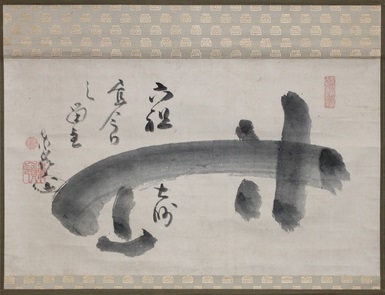
The Sixth Patriarch painting and inscription: The Great Teacher Sixth Patriarch -- I'm pleased to say that today I'm absent.
Paper: 34.2 x 59.3 cm
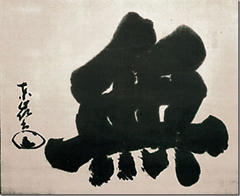
Mu
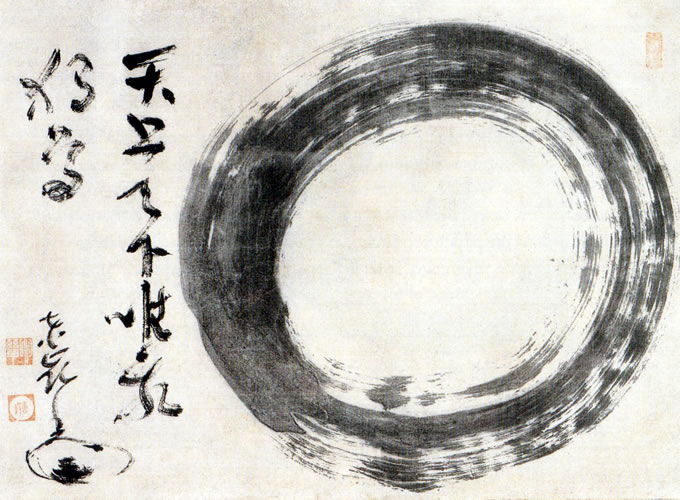
Enso
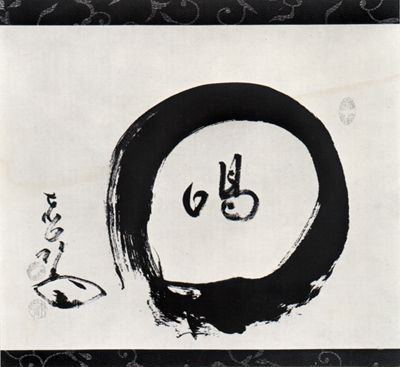
Katsu
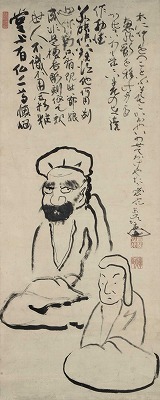
Gautama Buddha & Manjushri
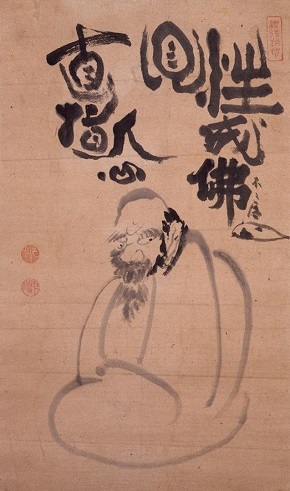
Bodhidharma

Hakuin
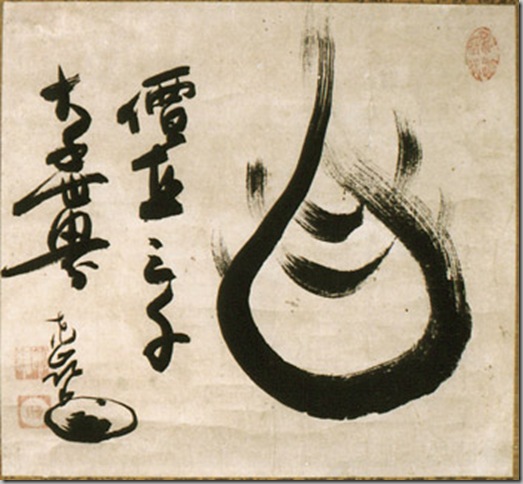
Zen jewel

Nin (Patience)
Signed Torei and with clam kao, sealed Unmon Rinzai hyakuhu za..., Torei and another seal
Hanging scroll; ink on paper
(120.3 x 27.3cm.)
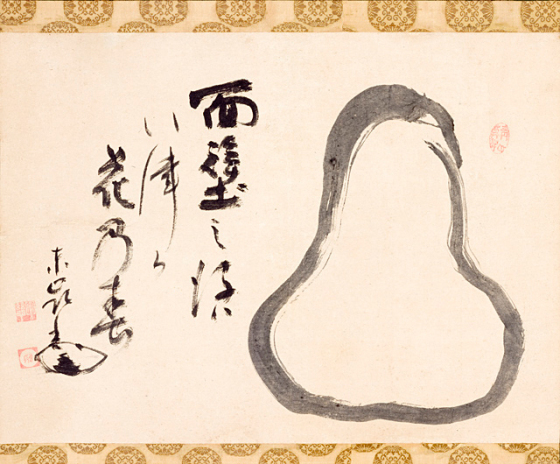
Meditating Daruma
Hanging scroll; ink on paper
Image: (36.83 × 49.53 cm)
LACMA, Gift of Leslie Prince Salzman (M.2006.207)
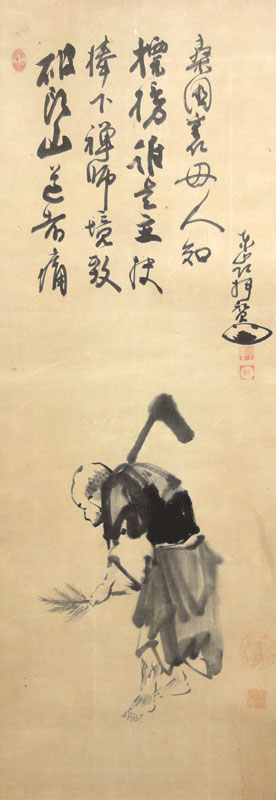
Rinzai saishou 臨済栽松 (Rinzai planting pines) by Torei
34,1 x 98,1 cm
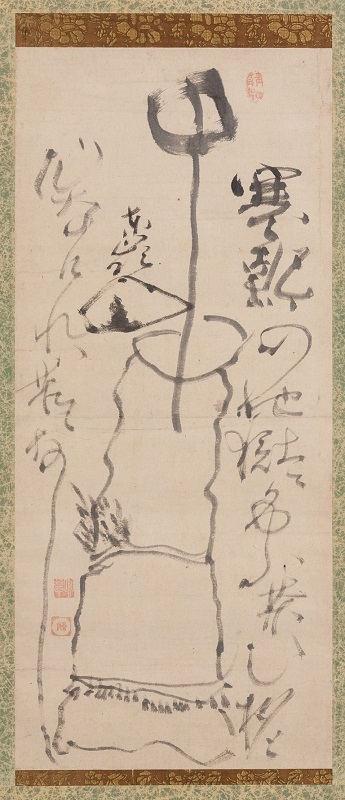
茶柄杓図 東嶺圓慈
Tea ladle by Torei